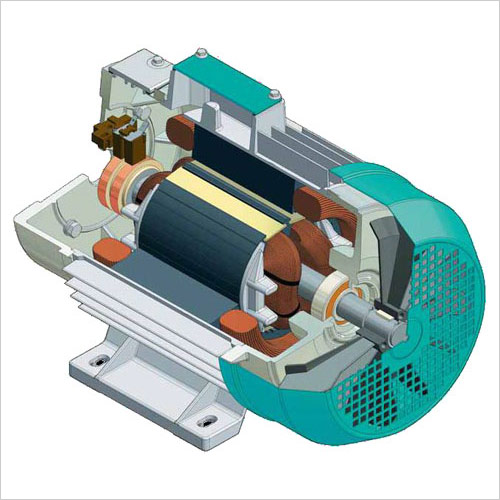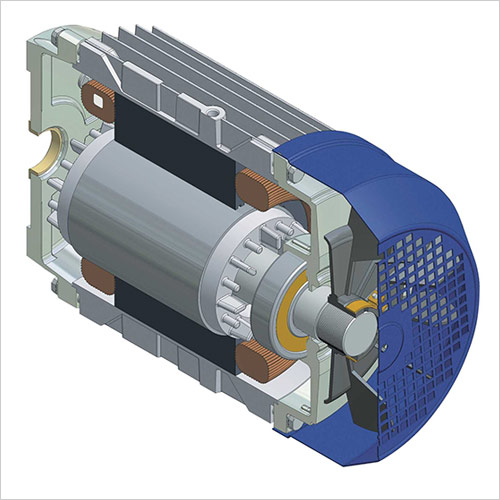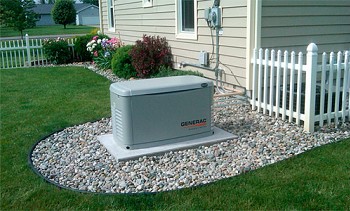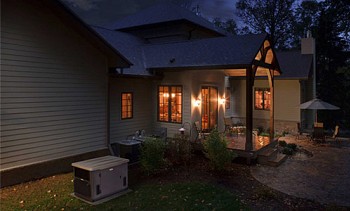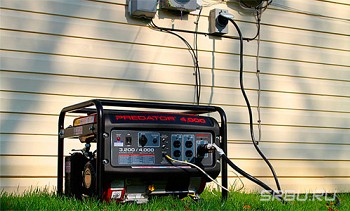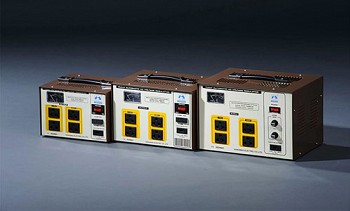A stand-alone electric power generator is an indispensable device if interruptions often occur on the main line or if it has not yet been let down, for example, at a construction site. Rarely when there are doubts about the need for an autonomous source of electricity, but how to choose a gas generator, it is not so easy to determine. Here you have to evaluate a number of parameters: the optimal type of fuel of the device and its power, the need to power three-phase consumers, which type of generator to use, select its additional elements and evaluate how easy it is to install and connect the selected model.

Content:
- Autonomous power plant
- Gasoline, diesel or multi-fuel generators
- We determine the range of tasks
- Single phase or three phase generators
- Used type of generator - synchronous or asynchronous
- How to choose the right power autonomous power plant
- Additional elements of an autonomous generator
- Installation and connection of a power plant
Autonomous power plant
In fact, any gas generator is a device for converting energy stored in fuel, first into mechanical and then into electrical. Based on this, any gas generator should consist of the following components:

1. Gas tank.
2. Ignition switch.
3. Low oil pressure indicator.
4. Voltmeter output voltage.
5. Sockets.
6. Frame.
7. Electricity generator.
8. Jockey wheel
9. Oil dipstick and neck.
10. Engine.
11. Manual starter.
12. Carburetor.
13. Air filter.
14. Handle for moving the unit.
Internal combustion engine (ICE). Provides autonomous operation of the entire device, converting fuel energy into shaft rotation. Mostly gasoline and diesel ICEs are used, and there are also gas-powered models. In addition to the type of fuel, the engines are divided into two and four-stroke ones - the former are much more compact, but require a gas-oil fuel mixture to operate, and the latter are distinguished by more “even” operation, better efficiency and less need maintenance. Also in the characteristics of the engine can be found abbreviations "OHV" and "OHC". The first means that the “upper valve” technology is used, which reduces fuel and oil consumption, and the second indicates a novelty in the engine industry - the upper position of the crankshaft, which allowed the manufacturer to reduce wear on parts, increase productivity and add efficiency to the engine.
Starter - to start the engine. It can be manual (when starting with a cable) or automatic (the scheme is used as in cars - the start is made by turning the key). In the second case, the start-up circuit can be supplemented by a controller that is connected to the main network and when the voltage disappears in it, the gas generator is started.

Fuel tank. Everything is simple here - the bigger it is, the longer the generator will work without refueling. But since household class generators need to take regular breaks, often the size of the tank is calculated so that the fuel is just enough for the recommended length of time for continuous operation.
Electricity generator. Responsible for converting the mechanical energy of the rotation of the ICE shaft into electrical energy. In appearance, this is the same electric motor, but with the opposite principle of action - when its shaft rotates, voltage is induced at the winding terminals. Depending on the class of the entire device, synchronous and asynchronous generators are used.
Coupling. Each mechanical device during operation creates some vibration due to which it is inexpedient to spend efforts on precisely observing the alignment of adjacent mechanisms. The task of the coupling is to transmit rotation from the ICE shaft to the electric motor, while allowing their shafts to be located relative to each other with some error. Usually it is a pair of tapes made of hard rubber or similar material that will transmit torque, but at the same time remain sufficiently ductile.
The power part of the electrical circuit. An analogue to the apartment entry panel - here are the circuit breakers and outputs for connecting consumers of electricity.
Frame and body. The mobility of the entire device and its degree of protection against rain and other climatic influences directly depend on the quality of their performance.
In addition to the required components, often in the generators there are additional elements, the availability of which depends on the manufacturer or the device configuration offered by the store.
Gasoline, diesel or multi-fuel generators
It would seem what the gas generator should work on, primarily depends on the cost of fuel and its availability in a particular region. At first glance, everything is logical - diesel fuel is cheaper than gasoline, and gas, in turn, has an additional advantage besides the lowest price - it can also be supplied through the gas pipeline (and interruptions in gas supply occur much less often). But the fact that manufacturers offer devices that run on all types of fuel suggests that each of them has its undeniable advantages, which must be taken into account when choosing.
Pros and cons of gasoline generators

For a number of reasons, gasoline engines are the most common in domestic autonomous generators that are used for domestic purposes or provide electrical equipment at small construction sites - for example, in the construction of a summer house. The advantages of their use are as follows:

+ pros
- Relatively low cost, which is much lower than that of diesel counterparts with similar characteristics.
- Smaller overall dimensions and weight of the device as a whole.
- Easy start of the engine at sub-zero temperatures - the principle of the engine allows you to start it without any difficulties at temperatures up to -20, and in some cases even lower.
- Silent operation of the motor - the sound volume is within 70 dB, which is comparable to the humming of a vacuum cleaner not at the highest speeds.
- The ability to work at idle - with a minimum load.

- Minuses
- Gasoline engines have a relatively low motor resource - few models can step beyond the mark of 5,000 hours.
- The design of the engine involves regular maintenance - without prevention, the likelihood of failure is significantly increased.
- High requirements for fuel quality.
- The maximum power of the generator does not exceed 15 kW.
Permissible errors for the output voltage and frequency of the electric current are 10 and 4%, respectively, of those declared in the device passport.
Advantages and disadvantages of diesel generators


Diesel autonomous power generators are more common in those industries where power and reliability are paramount. They have the following positive and negative sides:

+ pros
- Power significantly exceeds gasoline analogues with similar characteristics. If for the latter the limitation is 15 kW, then domestic diesel engines can give out power up to 25, and stationary diesel engines can supply more than 40 kW.
- Diesel engines are characterized by more “even” operation.
- The design of the diesel engine makes it possible to operate it without major repairs much longer than gasoline - high-quality models have a resource of 40 thousand engine hours.
- The principle of operation of the diesel engine makes it more resistant to fuel detonation, and also increases the fire safety of the whole device.
- General requirements for fuel quality are lower than gasoline engines.

- Minuses
- The high cost of the engine itself.
- Since the ignition of the fuel mixture occurs from compression, a cold engine at low temperatures starts poorly at -5 0C and below.
- If less than 40% of the load (of the nominal value) is connected to the generator, the diesel engine may stall.
When using a diesel engine, the error from the voltage and frequency stated in the passport is 1 and 2.5%, respectively.
Gas (multi-fuel) autonomous electricity generators

In fact, these are the same gas engines that HBO is installed on, allowing you to switch between operating modes - gas / gas. Such a universal (by type of fuel) engine retains all the pros and cons of a gasoline engine, but acquires several more advantages:
- Reduced cost per kilowatt hour, since the price of gas is the lowest of all fuels.
- Longer service life, since less gas is formed in the cylinders during gas combustion.
- The ability to work from the gas main - in this case, the uptime depends only on the capabilities of the engine.
- The reducer allows you to use several types of gas as fuel: natural (from the gas main), liquefied (sold in cylinders), coke, pyrolysis, biogas and others used in industry.
Although motorists note that the installation of HBO slightly reduces engine power, but since the generator does not need to change load conditions often, this difference is not felt at all.
We determine the range of tasks
The first thing to do before choosing a gasoline generator is to decide on the tasks that will be solved with its help. It is clear that for a summer cottage and a manufacturing enterprise you need to purchase completely different devices, but which one is suitable in a particular case must be determined on the spot. Even if you just buy a generator “like a neighbor”, it’s not a fact that its needs will be the same, which means either an overpayment for excessive power or the inability of the gas generator to cope with the load imposed on it.
Reserve or permanent source of electricity
If you install the generator in the area to which the power supply line is connected, then they will be used only in case of interruptions in the supply of electricity. Often, a large margin is not required - 3-4 hours of uninterrupted operation, for which gasoline generators are designed, will quite help to wait for the shutdown. Also, such devices can be used in places where there is no electricity at all, but the front of the work is small and does not require its constant availability.
When you need a constant source of electricity, even if you need to connect not very powerful electrical appliances, you need to look in the direction of diesel devices. Even low-power generators can be designed for long-term operation, and devices emitting 15 kW and more are generally equipped with water cooling and can be turned off all day and night.

Gas generator power and intensity of use
These two concepts are often incorrectly correlated with each other. Depending on the task, you can choose a gas generator that can work for an hour without a break, but at the same time it will provide electricity to the device with a total capacity of up to 10-15 kW.
On the other hand, you can choose a generator that will last 4-5 hours, but in total you can “hang” a load of no more than 5 kW on it.
The same applies to generators for uninterrupted operation - if there should not be any questions here over time, then their power can be very different.
terms of Use
Gas generators do not have to be used for any kind of work - there are a number of portable models that you can take with you when you go outdoors: on a camping trip or fishing. The weight of such devices is about 15-25 kg and they are specially made in the form of a suitcase with a handle for easy carrying. Also, such devices will be appreciated by specialists who may need electricity when conducting field work.

For work on a construction site, more powerful gas generators are needed, but still possessing sufficient mobility to move them around the construction site. In this case, it is necessary to choose frame-type generators - some of them are even equipped with wheels so that they can be moved by one person.
It is also necessary to estimate in advance whether there are any restrictions on the permissible noise level at the place of use of the device. If so, it is better to select gasoline models. Also, such generators will perform better in the cold season, while diesel generators will have to be additionally warmed up before starting.

It is also worth paying attention to the level of dust and moisture resistance of the body - the gas generator body is responsible for this. Standard marking is applied here - from IP24 to IP54.
Single phase or three phase generators
Here it is necessary to consider several very important points, the first of which is the cost of the devices. Three-phase generators, like single-phase ones, are available with all types of engines - gasoline or diesel, but those devices that produce three phases are much more expensive than single-phase ones. At the same time, some buyers prefer to take a three-phase generator and use it to connect single-phase electrical appliances. They are guided by the fact that three-phase gas generators are supposedly generally more reliable, and most importantly - they are universal - when three-phase equipment appears on the farm, it will be where to connect it.
In practice, however, everything is different - for the three-phase generator to work comfortably, the load on its phases should be distributed evenly and this is possible only when three-phase current consumers are connected to it or correctly distributed in phases of single-phase devices. Few people can competently do the latter, especially considering that all these devices must be switched on constantly - otherwise, the load will be out of phase and the generator will work for wear. This means that it will produce non-rated voltage, the generator winding will overheat, the engine will run out of oil and fuel - if you force the gas generator to work in this mode for a long time, it will fail quickly enough.
As a result - if there is no urgent need to connect three-phase equipment, then it is always better to buy a single-phase generator. In the event that there are many single-phase devices and one three-phase, then you need to look at the price - it may be cheaper to change this only device to single-phase than to buy a three-phase generator. If a three-phase gas generator is needed, but single-phase devices will be additionally connected to it, then it must be remembered that equipment with a difference in power of more than 25-30% cannot be “hung up” on adjacent phases. In simple words - if an electric kettle with a power of 2 kW is connected to one phase, a pair of 100W bulbs each and the other does not turn on anything, then the generator currently feels really bad.
Used type of generator - synchronous or asynchronous
Fundamentally, the difference between synchronous and asynchronous generators is the frequency of rotation of the magnetic field in the stator windings - the fixed part of the device. In a synchronous generator, it is equal to the rotor speed, and in an asynchronous generator it is behind, which determines its name.
If you do not go into technical details, then in simple words for the user, this difference means that the synchronous generator produces a more stable voltage, while the asynchronous generator can “float” within 10% of the nominal value and completely depends on the engine speed. This means that after a certain number of hours, the stability of the asynchronous generator will lose to the synchronous one. There is also, though not always obvious, but the dependence of the stability of the asynchronous operation on the quality of the fuel - if the ICE "sneezes", then the voltage will again "float".
Another important criterion is the ability of the generator to withstand short circuit currents. There is a clear advantage for asynchronous devices, since there is no additional winding on their anchor (rotor). Accordingly, asynchronous devices are better suited for powering welding machines.
The last important point is the dust and moisture resistance of the devices, which also depends on the presence and absence of windings on the rotor. If the asynchronous can be made completely closed (there is no winding at the armature), then a constant flow of air must be provided to the rotor of the synchronous generator to cool the winding. If you plan to work in places with strong dust, then you will additionally have to solve the problem of filtering the air, which will cool the armature winding.
As a result, a structurally asynchronous generator is simpler and has better protection against dust and moisture, and is also better suited for feeding welding equipment. In turn, the synchronous gas generator is characterized by the stability of the generated voltage, but requires periodic preventive maintenance of the rotor brush assembly. But the last problem is gradually disappearing, as manufacturers have mastered the production of brushless synchronous generators (with squirrel-cage rotor) - these are the devices that are now installed on the vast majority of gas generators.
How to choose the right power autonomous power plant
In general, the selection of the power of a gas generator is reduced to the arithmetic addition of the number of watts for which all the devices that will be connected to it are designed. This opinion is completely true, but with some reservations, which must be remembered when making calculations.
What electrical appliances will necessarily work at the same time. If in the garage there is, for example, a lathe, then it is unlikely that they would be used in parallel with the compressor. On the other hand, if there is an electric oven in the kitchen, then with it it may well start a dishwasher or a bread machine.
After calculating the power of all devices, which theoretically can be turned on simultaneously, about 30% should be added to the result obtained. This is due to several considerations:
- Just in case, which are different.
- So that the generator does not work continuously in the "wear" mode.
- Starting currents are leveled, which are several times higher than the rated values of electric motors (of the same refrigerator).
- Such a reserve helps to take into account, in addition to the active, the reactive power of the generator itself and the devices connected to it, which can be 1.5-2 times higher than the declared ones (this is mainly true for electrical appliances inside which there is a winding). If manufacturers indicate the equipment capacity in Volt-Amps, then the calculations will be somewhat simplified.
As a result, despite the apparent simplicity of calculations, if a gas generator is selected for the simultaneous operation of numerous electrical appliances (for example, for a workshop), then it is better to seek advice from specialists. A poorly selected power will result in an excessive consumption of fuel for an excessively powerful generator, or the need to periodically turn off part of electrical appliances.
Additional elements of an autonomous generator
This includes various devices that simplify the maintenance of the gas generator, but can be installed depending on the wishes of the manufacturer. These are mainly various sensors, status indicators or protective devices.
Sockets. Of course, which of them will be installed by the manufacturer, first of all depends on the class of the generator - one or three phase. Also, sockets, even single-phase, can be for connecting standard devices and power. Still, some generators have a 12 volt output, for which there are separate terminals.

Voltmeter. It would seem that this electrical appliance must be present in the electrical circuit of the gas generator. Often this is the case, but on some low-power generators from well-known brands it may not be. It is difficult to assume the desire of manufacturers to save in this way - most likely this is an extra hint of their confidence in the equipment offered to customers.

Hour meter. It helps to accurately assess the time for the next preventive repair. It is not installed only on the lightest, budget models - in this case, it will be necessary to assess the state of the generator “naked eye”.

Fuel tank with fuel gauge and tap. Often engines and generators are manufactured by different manufacturers. At the same time, the engines for the initial inspection at the factory are equipped with their own small tank, which changes during final assembly. This is especially true of frame gas generators, on which they try to install a gas tank that occupies the entire useful area as much as possible. The usefulness and necessity of having a fuel level indicator and a tap for draining it, in case of incomplete production, each one determines for himself.
Installation and connection of a power plant
If the gas generator is not originally designed to work in difficult conditions in an open area, then it must be installed in a dry, heated room - this especially applies to devices used as a backup source of electricity.
Of course, manufacturers may indicate that the gas generator is able to work long and confidently in the temperature range from –30 to +50 and at the same time not be tempting. But here at least it is necessary to take into account the factor of thermal expansion of bodies and the likelihood of condensation. This means that if the gas generator is in an unheated basement, then its temperature will be equal to ambient. When it is necessary to start it up, the windings heat up, and when the generator is turned off, they cool down. They collect condensate, which over time can reach current-carrying contacts and cause a short circuit. With elevated temperatures, the situation is no better - no manufacturer will specify how long the gas generator will work in this mode, but obviously the device will need to be repaired much earlier.
The problem of exhaust gas removal and the elimination of noise from the operation of the gas generator must be solved individually in each case. Here you need to decide where to stretch the corrugated hose (so that the exhaust does not get into the house), and what would be better is to make sound insulation or place the gas generator in a separate room.

The connection scheme to the home circuit depends entirely on the capabilities of the outlets or terminals installed on the generator. If the generator is powerful and it has several outlets, then they are connected in parallel. Switching to power from the central power supply or generator is done either manually or through automation, which monitors the presence of voltage on the line and gives the start / stop command of the gas generator engine and connection from the desired source.
This is all information that can help you decide on your own which gas generator to choose for your home, workshop or trips out of town.This task is very easy to calculate if the generator is simply needed as an autonomous source of electricity for not too long operation of one or more devices. When a gas generator is purchased as a backup for the whole house or production workshop, the complexity of the calculations will increase and if there are doubts about the correct choice of a device, it is always better to consult with specialists, especially since the information provided will allow them to ask the right questions.

